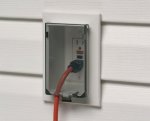jxofaltrds
Retired ESI
- Location
- Mike P. Columbus Ohio
- Occupation
- Creator
If I have a floor receptacle outlet installed on a vinyl floor then add a 3/4" wood floor around it is it still flush with the floor? No.
Is it a big deal? No. Is it code compliant? No.
Forget that it may be a trip hazard, building code, does it meet the NEC?
Is it a big deal? No. Is it code compliant? No.
Forget that it may be a trip hazard, building code, does it meet the NEC?

